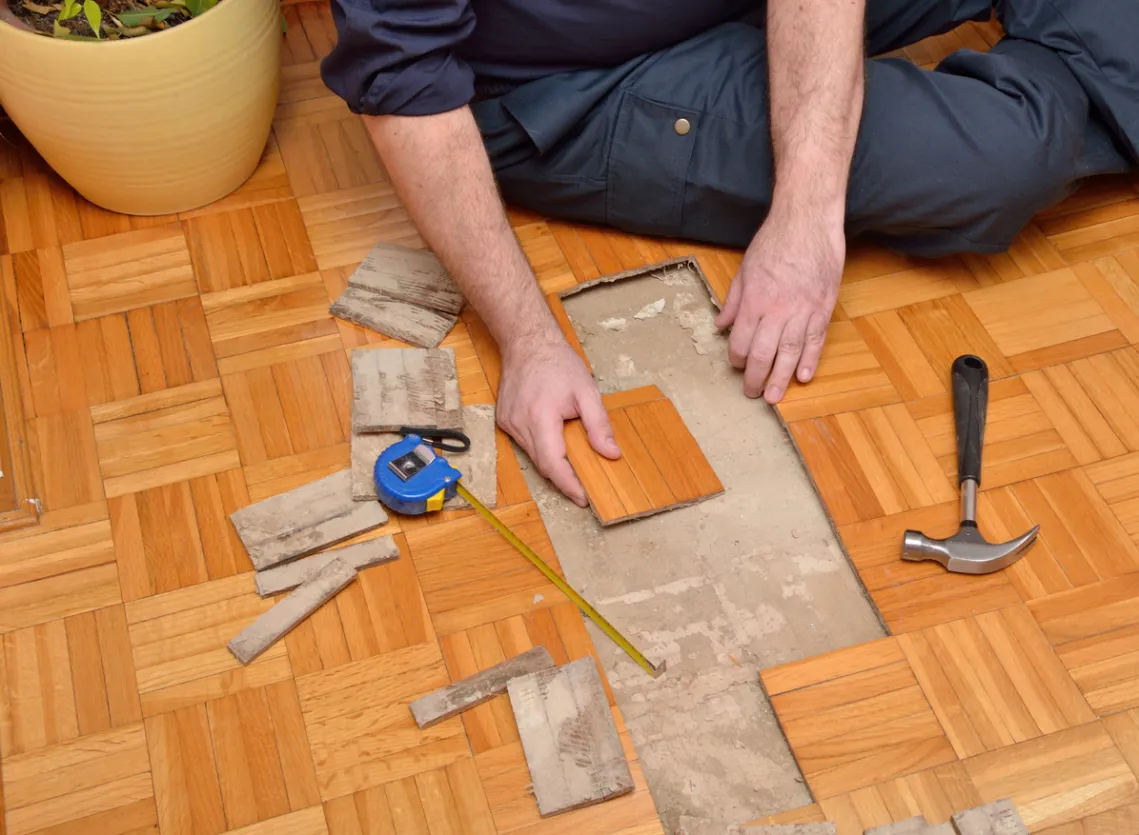
Floors that creak and squeak can make your peaceful home noisy. When daily footsteps trigger annoying sounds, it disrupts comfort. Understanding the cause of the squeak, such as humidity and floors, becomes important for proper repair.
Your flooring repairing options range from quick and painless process solutions to more involved repairs. You will quickly figure out the real issue by tracking down the squeak and checking for loose nails or bowed or uneven joists. If you find the solution complicated or the issue persists, calling in a professional flooring service makes all the difference.
Proven Methods to Fix Squeaky Floors
Several proven methods eliminate those bothersome sounds effectively. Each technique targets different causes of floor noise. Choose the right approach for lasting results.
Solution 1: Lubricate the Floorboards
Lubricating the joint where planks rub together is a fast way to address nuisance noises. This classic solution is perfect for tongue-and-groove hardwood floors that creak and squeak from simple friction. Start with the basics.
- Identify the noisy floorboards and thoroughly clean the dust or debris.
- Sprinkle powdered graphite, talcum powder, or baby powder directly into the cracks.
- Place a towel or cloth over the area and step on it repeatedly. This works powder deep into joints and silences the movement of floorboards.
- Repeat until the powder stops disappearing or squeaks disappear.
- Wipe any excess powder away with a wood floor cleaner for a tidy finish.
Sometimes, dry air makes things worse. If humidity and floors become an issue, running a humidifier helps maintain optimal wood moisture and prevents gaps contributing to floor squeaks. If one area squeaks, it is often worth checking nearby spots.
Solution 2: Tighten Loose Floorboards with Screws or Nails
Creaky floors are not always about friction; sometimes loose boards or improperly secured subfloor needs attention. Fastening down these loose components helps.
- Locate the squeak and identify the nearest floor joists by tapping the floor gently.
- To prevent splitting, a drill creates a pilot hole at the marked squeaky spot.
- Sink either finish nails or self-drilling wood screws into the subfloor and joist.
- Secure from above or below, depending on access beneath the floor.
- Tap the finish nail below the floor’s surface using a nail set for a seamless look.
- Fill any holes with wood filler and touch up with matching sandpaper.
Check that adjoining planks are tight. You do not want new gaps or movement. Sometimes, specialty scored screws work best for hardwood installations; just drill, drive, and then break the head off for a nearly invisible finish.
Solution 3: Shim the Subfloor or Joists
Shimming may be your answer if your squeaks echo from deep below. Gaps between the subfloor and joists can create persistent noise.
- First, locate the squeak. Access beneath the floor with a crawlspace or unfinished basement is helpful, but not necessary.
- Use a flashlight to check for sagging joists, gaps, or loose or damaged components.
- Slide a wood shim, dipped in wood glue or construction adhesive, gently into the gap between the subfloor and joist.
- Apply enough pressure to fill the void, but do not lift the floor above.
- After placing the shim, trim excess material with a utility knife.
Support block or wood block solutions also bolster weak joists. This works especially well where the flooring system has vertical or lateral movement.
Solution 4: Use Specialty Repair Kits
Sometimes, the best option involves specialty solutions to fix squeaky floors in tough situations, such as under carpet or high-traffic rooms.
- Purchase a breakaway screw kit or similar system made for invisible repairs.
- Find the joist location under your flooring using a stud finder or tapping on the surface.
- If necessary, drill pilot holes and then drive the breakaway screws through the floor covering and into the joist below.
- Use the kit’s tool to snap off the screw head just beneath the surface.
- Fill the small void with color-matched wood filler and smooth the area with sandpaper.
Kits like these allow you to secure from above, even if you can not access beneath the floor. They are designed for a quick and painless process that does not require you to rip out carpet or finish material.
Solution 5: Reinforce or Support Joists
If you have tried everything but floor squeaks persist—or you spot bowed or uneven joists, it’s time to reinforce that structure.
- Inspect the full length of floor joists for sagging, major movement, termite damage, or water damage.
- Measure and mark where the joists bend or the subfloor lacks support.
- Cut a support block, such as a 2×4, to span across the trouble area.
- Apply construction adhesive to the block and place it tightly against the existing joist under the subfloor.
- Use self-drilling wood screws or nails to attach the block.
If more reinforcement is needed, reinforce (sister) the joist by connecting a new joist section alongside the old one.
Conclusion
Squeaky floor repairs range from simple lubrication to structural reinforcement. Basic techniques resolve most causes of squeak problems. For complex issues, consider a professional flooring service. They spot hidden problems fast and save you time and effort. Do not let floor noise linger; take action today for peaceful steps and a quieter home. Your floors will thank you.

Leave a Reply